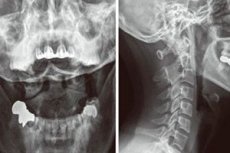Rotational subluxas of Atlanta
Last reviewed: 23.04.2024

All iLive content is medically reviewed or fact checked to ensure as much factual accuracy as possible.
We have strict sourcing guidelines and only link to reputable media sites, academic research institutions and, whenever possible, medically peer reviewed studies. Note that the numbers in parentheses ([1], [2], etc.) are clickable links to these studies.
If you feel that any of our content is inaccurate, out-of-date, or otherwise questionable, please select it and press Ctrl + Enter.

Rotational subluxas of Atlanta result from the impact of direct or indirect violence or active uncoordinated contraction of the neck muscles.
Atlanto-axial subluxation causes deterioration of the neck rotation, characterized by excessive movement between the first (C1) and second (C2) cervical vertebra as a result of either a violation of the bone or ligamentous apparatus.
Epidemiology
According to MN Nikitin (1966), they amounted to 31.5% in relation to all injuries of the cervical spine and 8.8% to all injuries of the spine. Such a high percentage of traumatic rotational subluxations of the Atlanta, apparently, depends on the special selection of these victims - 78 victims of this kind were observed for 11 years.
 [3]
[3]
Causes of the rotational subluxation of atlanta
Rotational subluxas of the atlanta may arise as a result of the impact of brute mechanical force (head impact on the river bottom when diving) or slight mechanical violence (sharp turn of the head backwards).
 [4]
[4]
Risk factors
Congenital:
- Down syndrome (20%).
- Morkio syndrome.
- Spondylophyseal dysplasia.
- Osteogenesis imperfecta.
- Marfan's Disease.
- Neurofibromatosis type 1 (NF1).
Arthritis:
- Rheumatoid arthritis.
- Psoriatic arthritis.
- Reiter syndrome (reactive arthritis).
- Ankylosing spondyloarthritis.
- Systemic lupus erythematosus (SLE).
Purchased:
- Injuries.
- Zagothy abscess / Grisel syndrome.
Symptoms of the rotational subluxation of atlanta
Symptoms of rotational subluxations of the atlanta are quite typical and consist of the following main symptoms: the forced stationary fixed position of the head with its inclination and rotation in the “healthy” side; pain in the upper, cervical; tension of the neck muscles on the “diseased” side, i.e., on the subluxation side of the atlas mass; limited rotation of the head in the "sick" side. Radiological is determined by the asymmetrical location of the atlas in relation to the axis due to the tilt and horizontal shift of the atlas to the "healthy" side.
 [7]
[7]
Treatment of the rotational subluxation of atlanta
Treatment of rotational subluxation of atlas consists in reducing subluxation and subsequent immobilization. Reduction can be carried out by stretching the Glisson loop or by one-time reposition.
The choice of the reduction method depends on the qualifications of the physician and the presence or absence of associated injuries. Simultaneous reduction is shown with uncomplicated rotational subluxations.
After resetting, immobilization is performed with either a craniothoracic plaster cast, or a Schantz collar with a large occipital visor for 4-6 weeks. In some cases, you can use a cotton-gauze collar Shantz. In complicated cases after the reduction, immobilization is carried out for a longer period, depending on the nature of the additional associated damage.

